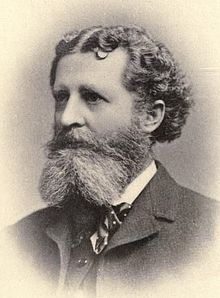George Marx (zoologist)
George Marx (born June 22, 1838 in Lauterbach , Grand Duchy of Hesse , † January 3, 1895 in Washington, DC ) was a German-American arachnologist , scientific illustrator and physician .
Life
education
Marx was the son of a court chaplain . At the age of fourteen he attended high school in Darmstadt. His father wanted his son to succeed him, and so Marx began to grapple with Hebrew . During his school days he was primarily interested in botany and showed such a skill as an artist that he illustrated a book on the local flora . Against his father's wishes, he decided to study pharmacy because it gave him the opportunity to pursue his interest in botany.
Emigrated to America and served in the American Civil War
After completing his pharmacy studies in Giessen , Marx emigrated to the United States in 1860 . When the civil war broke out , he joined the Union Army and served as a simple soldier until the first battle at Bull Run in July 1861. Because of his medical and pharmaceutical knowledge, he received a post as an assistant doctor in the medical service . In July 1862, Marx was honorably discharged because of a serious wound.
Professional career and research
Marx then settled in New York City and worked as a pharmacist for the duration of the war. In 1865 he moved to Philadelphia, opened a shop, and married Minnie Mason. During his time in Philadelphia, he devoted himself to collecting and studying arachnids . In 1878 he moved to Washington DC, where he worked as a natural history illustrator for the United States Department of Agriculture (USDA) in the Department of Entomology. Marx made a name for himself as an accomplished artist, and many of the writings published by the Department of Entomology included illustrations by him. In 1889 he was appointed director of the USDA's newly established illustration division.
In addition to his work as an illustrator, Marx continued to collect and study spiders. He published his first work On Some New Tube-Constructing Spiders in 1881 and wrote another thirty articles on arachnids, many of which were illustrated with his own drawings. He became a valued expert on spiders, working with well-known arachnologists in America and Europe, including Tord Tamerlan Teodor Thorell , Eugène Simon , James Henry Emerton, and George Williams Peckham . Marx completed and published The Spiders of America , which remained unfinished due to the death of the original author Eugen von Keyserling .
Marx was a co-founder and an active member of the Entomological Society of Washington and served as president of the organization in 1891. In addition to all his other activities, he also found time to pursue his medical studies and in 1885 received a doctorate in medicine from Columbian University (now George Washington University ).
Dedication names
According to Marx, the species are Aphonopelma marxi ( Simon, 1891 ), Cosmophasis marxi ( Thorell, 1890 ), Hypomma marxi ( Keyserling, 1886 ), Philodromus marxi Keyserling, 1884 , Satilatlas marxi Keyserling, 1886 , Thymoites marxi ( Crosby, 1906. ) And Trebacosa marxi ( Stone, 1890 ).
literature
- Anonymous: Obituary and Bibliography of Dr. George Marx . In: Proceedings of the Entomological Society of Washington . 3, No. 4, 1895, pp. 195-201.
- Anonymous: The Marx Collection of Arachnida . In: The Canadian Entomologist . XXVII, No. 9, 1895, p. 272.
| personal data | |
|---|---|
| SURNAME | Marx, George |
| BRIEF DESCRIPTION | German-American arachnologist, scientific illustrator and physician |
| DATE OF BIRTH | June 22, 1838 |
| PLACE OF BIRTH | Lauterbach , Grand Duchy of Hesse |
| DATE OF DEATH | January 3, 1895 |
| Place of death | Washington, DC |

